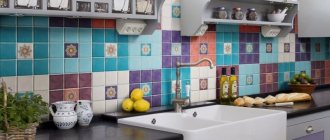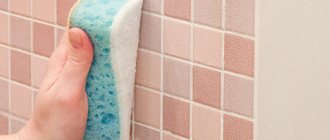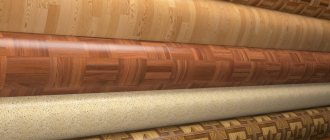After many years, the tiles become unusable and lose their shine and former beauty. It is not always possible to make repairs, but updating the bathroom is still required. The only best option is to paint ceramic tiles.
Painting tiles is a way to breathe new life into them.
You can paint any tile and any paint, however, we are talking about the bathroom, that is, a room that is constantly in contact with water. This means that the paint must be especially durable and resistant to moisture.
The need to paint tiles
Although this way of decorating a room comes to mind, in fact, many do not know for sure whether it is possible to paint tiles in the kitchen. This method is really not very common. Therefore, it is worth noting especially in what cases there may be a need for such an emergency mini-repair of kitchen ceramics.
- Updating the kitchen space from an aesthetic point of view. The painting method is the most elementary and least expensive of all, so it is ideal for quickly transforming the kitchen, bathroom and any other room where it is needed. With this approach, it is possible to radically change the design of walls and floors without unnecessary hassle and dust;
- Change of furniture. Replacing furniture elements inevitably entails replacing wall and floor cladding. This option involves changing the color of the tiles according to the new design project;
- A change in the style direction in the interior entails a revision of all existing types of decoration. Including the appearance of ceramic tiles;
- The need to disguise tile defects. Painting individual sections of the tile allows you to hide small flaws in the coating that have arisen during its intensive use. Moreover, you can do this completely independently, you just need to be able to hold a brush in your hands and use paint;
- Applying decor to a tiled surface allows you to complement the design with some colorful patterns and even images.
You don’t need much to decide to paint your backsplash. The main thing is to gain creative inspiration and create your own masterpiece, albeit small, where a smooth ceramic surface will act as a canvas.
What paint should I use to paint ceramic tiles?
Over time, the tiles fade and lose their former beauty.
Since it is not always possible to make repairs, tile paint will help to renew the coating.
You can transform any type of tile, but it is important to remember that the paint for bathroom tiles must be durable and moisture resistant.
Purposes of coloring
The choice of paint for tiles must be approached with the utmost seriousness, since the quality and beauty of the new design will depend on this.
Therefore, before purchasing, it is recommended to consult with a specialist who will tell you which coating will be optimal for a particular room.
The choice of coating largely depends on the reason why the owner wants to change the design. Goals can be of the following nature:
- Aesthetic considerations - old tiles installed in the kitchen or bathroom look unpresentable or faded. If you don’t have money for new tiles, ceramic tile paint comes to the rescue.
- For waterproofing purposes, the paint will reliably protect the floor or wall covering from moisture and ensure complete sealing of the seams.
- Change of style - painting floor or wall tiles will help you radically change the interior, while emphasizing the overall palette of existing shades, and you can also add new elements.
- Decoration – the ability to create various images, unobtrusive patterns and ornaments.
- Repair - if the furniture and interior items are updated, it is not at all necessary to change the tiles. The coating can simply be painted.
If the tiles have a beautiful appearance, it makes sense to use sealed grout for the joints, after removing the old one.
It is also worth remembering that even the most durable coatings will still peel off over time when exposed to temperature changes and high humidity.
Can tiles be painted?
Can. This unique, durable, moisture-resistant coating can easily be renewed using just this method. At the same time, the ceramic surface is painted very well - the main thing is to choose the right paint and choose the place where it will be applied.
Is it possible to paint tiles on the floor?
On walls, floors and even ceilings, tiles can be safely updated with a fresh coat of paint - there their contact with water will be minimal, and the paint is unlikely to wear off quickly. But it is not recommended to paint tiles located inside showers directly under your feet or directly above the bathtub. The fact is that the durability of the paint and varnish coating, even the highest quality, directly depends on the intensity of exposure to water. And in the shower and above the bathtub, an environment that is too humid for even the highest quality and most reliable paint. In such places, the coating will quickly begin to peel off and all the work will have to be done again. Conclusion - you can safely paint absolutely any tile if it has moderate contact with water.
Painting tiles on a bathroom wall
With the help of paint, the interior of a kitchen or bathroom can be constantly changed as soon as such a desire arises from the owner of the room. Previously, this was exactly how apartment owners got out of the situation; this method of renovating premises was quite common.
On a note! If high-quality paint was used, and all work was carried out strictly according to the rules, then such a coating can last on the tile for up to 30-50 years.
Painting tiles: pros and cons
Tile is a strong and durable decorative covering. It can be glossy or matte. It depends on the texture of the top layer: smooth or slightly rough. Theoretically, anyone can paint it themselves. But the strength of the color may vary. Thus, coloring preparations adhere worst of all to glossy bases. It requires special pre-treatment.
It is important to choose the right composition. Some paints are absolutely not suitable for these purposes. In general, coloring is possible for any type of tile.
Pros of coloring
- Quick interior update.
- Removing visible defects of the old coating.
- Variety of color options.
- Minimum cash investment.
- Easy to do. An inexperienced master can handle the job.
Minuses
The disadvantages of the solution include the fragility of the new coating for some types of paints. True, nothing prevents you from updating it from time to time. Then the result will be better. It is better to paint floor tiles only with epoxy or latex compounds. Otherwise, intensive use will quickly deteriorate the new finish. But painted ceramic wall cladding lasts longer.
Painting can be continuous or selective. In the first case, paint is applied to the entire area of the walls. In the second, only fragments are painted, patterns, panels, etc. are drawn. It is especially good in this case to use a stencil. This way you can zone a room and draw attention to a specific area of it. For decoration, choose only one tone or play with color. Close combinations or contrasts - there are no rules here. Any design the owner likes can be used.
Look at the photo: before and after staining. How the old bathroom was transformed.
Preparing tiles for painting
From the very beginning you need to wash the base. The paint is applied in a thin layer and even small irregularities - drops of grease, lime stains - everything will be visible. Therefore, we wash and clean thoroughly. If you decide to paint the floor tiles in the bathroom, first remove all silicones, grout, level and clean the seams.
It all starts boringly - with cleaning
Further. If the tile is glazed, it is better to scratch the glaze. There are many ways.
- If you have a grinding machine, this will simplify the task. We use sandpaper with medium grain and make the surface rough.
- You can try a grinder with a grinding attachment. But it will be too dusty.
- Wire brush.
- A block wrapped in coarse or medium grit sandpaper. We select the grain experimentally.
After sanding, dust should be removed (with a vacuum cleaner). The following describes the processing.
Brushes, scrapers, abrasive and non-abrasive detergents - anything to keep the base clean
Some primers have such good “adhesion” that there is no need to sand a smooth surface (for example, Zinsser Bulls Eye). Then the base should be washed and degreased. For degreasing, you can use White Spirit 1050 or Pensselipesu detergent. Wait for it to dry.
Work on painting tiles begins with preparing the surface and the room itself. To begin with, it is recommended to clear the room of furniture and interior items that may interfere with the work. It is recommended to cover anything that cannot be removed with plastic wrap to prevent drops of paint from falling onto the surface. While the paint on smooth objects can still be wiped off, the upholstery of the upholstered furniture cannot be saved without dry cleaning.
It is advisable to cover the furniture with film
The surface of the tile itself also needs preparation. If you neglect this stage, the layer of paint and varnish material will quickly begin to peel off and crumble. The surface of the tile is first washed with some cleaning agent. If the tiles are painted in the kitchen, then it is important to remove all grease stains - the paint will not stick to them. You can degrease the surface using a special liquid or use vinegar or an alcohol solution.
Washing ceramic tiles
Then, as soon as the tile is dry, it is carefully sanded with sandpaper - it is necessary to make the surface slightly rough. Only in this case will the paint stick well. If the tiles on the floor are rough in themselves, then you can do without the grinding step.
We suggest you read: Is it possible to lay tiles on coating waterproofing?
It is also important to inspect all tiles before painting to make sure they are intact. Damaged elements must either be removed and replaced with new ones, or repaired.
Selection of paints and varnishes
Any paint consists of several main components. Pigments are responsible for the color of the composition; black and white paints are called achromatic, color chromatic. To form a film, binders are added to paints - polymers, oils, hydrocarbons, bitumen resins.
Solvents regulate the viscosity of paintwork materials; their chemical composition must be combined with the binder used in the paint. Fillers are used to improve properties. For example, matting additives increase adhesion, abrasion resistance, fire protection, and color uniformity.
For a bathroom whose walls and/or floors are tiled, the following paint and varnish compositions are suitable:
- polyurethane coating - a universal option for wet, dry, walk-through areas on walls and floors;
- epoxy enamel – floor covering;
- oil paint – protection with a layer of varnish is required;
- alkyd composition – walls in dry areas.
Water-based emulsions and dispersions are absolutely not suitable for painting glazed tiles, even if they contain a latex binder.
Polyurethane paint costs from 450 rubles/kg, the film layer is resistant to impact loads, abrasion, solar ultraviolet radiation, moisture, and high temperatures. Inexpensive epoxy enamels (from 150 rubles/kg) do not tolerate hot water well, otherwise their properties are similar to those of polyurethane paints.
The price of oil paints is similar to epoxy enamels. This finishing material is easier to work with and has high hiding power. However, when drying in air without heating, the time increases and the strength of the film layer decreases. Oil paints are quickly washed away by powders and detergents; they will have to be additionally coated with varnish.
Alkyd enamels, priced from 150 rubles/kg, have an additive to reduce the abrasion of the floor covering in walk-through areas - rosin. There are semi-matte and glossy compositions with moisture resistance as a basic bonus. Varieties of alkyd paint are glypthal enamels GF and pentaphthalic PF. They are applied to the FL primer, and floor coverings are usually painted with these paints and varnishes.
Some home craftsmen use so-called rubber paint in an aerosol can or buckets to decorate tiles inside the bathroom. In fact, dispersion paint and varnish material contains fungicides, pigments, preservatives, coalescent plasticizer, antifreeze and latex.
There is no solvent in such paints, they do not smell, and are ideal for enclosed, unventilated rooms. The price of 1 kg of paint, packaged in buckets, starts from 250 rubles.
Another popular solution among home craftsmen is chalkboard paint. School boards are treated with this composition, so the second popular name for paints and varnishes has become “chalk paint”. This facing material has the following properties:
- non-toxic, safe for humans;
- does not support or propagate combustion;
- forms a completely matte surface without glare;
- adhesion to the base is very high;
- The film layer is resistant to abrasion and mechanical damage.
A liter of slate paint costs from 1000 rubles when packaged in cans/buckets or one and a half times more expensive in an aerosol can.
For oil-based, epoxy and polyurethane paints, the tiles must first be coated with a layer of primer. In this case, the soil must contain an organic rather than an aqueous solvent.
Stained glass paint.
Drawings, ornaments, patterns are applied to the base background with special expensive stained glass paints.
Features of composition selection
If the tiles must shine, then it is better to choose glossy types of compositions. Satin paints are used for a semi-matte surface with a velvety effect. Water drops or streaks are not visible on such a surface.
Oil paint
Oil-based tile paint (MA) is the most budget-friendly option for painting tiles. Can be applied by brush, roller or spray. The drying speed of this paint is more than 24 hours and will vary depending on the type of drying oil (oil) used as a binder, the type of pigment, and also on the drying temperature. Coatings based on oil paints are characterized by low hardness and low water resistance, and are susceptible to destruction when exposed to alkalis (soda, washing powders, etc.). This type of coating is recommended for painting tiles on indoor walls.
Attention! Coatings based on oil paints are short-lived and cracks appear over time.
Alkyd enamel
Alkyd enamels are a relatively inexpensive product. Coatings made from alkyd enamel, compared to coatings based on oil paints, have greater weather resistance, resistance to detergents and mineral oils. They are characterized by high hardness, shine and moisture resistance. They can withstand temperature changes ranging from -50 to +60 ºС. The protective properties of such coatings are maintained for 4 years. Alkyd enamels with the addition of rosin are used to paint floor tiles.
Don't miss: How to clean grout lines between floor tiles: practical tips. How to clean the seams between tiles: rejuvenating the tiles for several years
Pentaphthalic and Glypthal enamels
Pentaphthalic and Glypthal enamels (PF, GF) have similar performance characteristics and are the most common alkyd enamels used for painting ceramic tiles. These include GF-115, PF-115 and PF-266. Enamels GF-115 and PF-115, due to their high weather resistance, are intended for outdoor use. PF-266 is used only for painting indoors, however, due to the high hardness of the coating, the enamel is recommended for painting ceramics located on the floor. It is recommended to use FL-03-K, 138, FL-OZH as a primer for these enamels.
Nitropaint
Nitroenamel (Nitropaint) (NC) is made on the basis of nitrocellulose varnish. This paint for ceramic tiles belongs to the segment of inexpensive paints and varnishes that have a high drying speed (10-30 minutes) at room temperature. It is recommended to apply nitro enamel to the tiles using a sprayer; when painting with a brush, due to rapid drying, smudges and unevenness may form. Due to its high hardness, the paint coating has low elasticity, which will subsequently lead to the formation of chips from physical impact on the painted surface. One of the advantages of using nitro enamels is the high smoothness and specularity of the resulting coating. It is used for painting both indoors and outdoors.
When painting tiles with nitro paint in a damp room, whitish stains may appear on the paintwork.
Attention! Nitroenamel is toxic and fire hazardous, so work must be carried out in a respirator and in a well-ventilated area.
Acrylic paints
Acrylic paints (water-based tile paint) are the most popular paint materials for painting ceramic tiles. These include polyacrylate (AK) and alkyd-acrylic paint (AC). Their disadvantage is their high price compared to alkyd enamels and oil paints.
Alkyd paints have high moisture resistance and weather resistance. Antiseptic agents, such as penotex, are added to some types of paint, which prevents mold from appearing on painted surfaces.
They are used for painting both indoors and outdoors.
Acrylic paints can be used to paint tiles in rooms with high humidity (bathroom, bathhouse, sauna, swimming pool, etc.). Both matte and glossy paints are available in different colors.
Glass paints
To apply decorative images (drawings) on tiles, so-called glass paints are used. It is not practical to use them for continuous painting of surfaces due to their high cost. Glass paints combine well with each other, retain color brightness and shade contrast, and are resistant to moisture. The drying time for this paint is 3 hours. After applying the design, it is recommended to apply a protective layer of clear varnish on top.
Epoxy enamels
Epoxy enamels (EP) – coatings based on them can be classified as special-purpose coatings with high performance qualities. They are recommended for painting tiles if there is a need to ensure such properties as: resistance to mechanical stress; resistance to alkalis, solvents and petroleum products; waterproof, weather resistant; dielectricity; fire resistance.
These coatings have high decorative qualities, resistance to wear, high temperatures and electricity. Retain their protective properties for 6 years.
Latex paint
When deciding how to paint bathroom tiles, many appreciated the advantages of latex paint. With its help, a moisture-resistant, plastic coating is created that does not deform when exposed to water and detergents.
The price is 90 - 420 rubles/kg.
Sometimes rubber latex paint is used, which is durable and strong. It does not have a pungent odor. The price of this variety is 255 – 650 rubles/kg. Also on the topic: Ceramic border for the bathroom: examples in the interior
Chalkboard paint
An excellent tandem of tiles and slate paint in the bathroom allows you to get a safe and highly durable coating with the effect of a school board, which is easy to clean.
This paint adheres perfectly to smooth surfaces, has no toxic components, forms a matte texture, and is resistant to mechanical stress.
The cost varies between 395 – 1090 rubles/kg.
To complete the painting, you need to purchase stained glass paints. Keep in mind that it is recommended to apply a primer based on an organic solvent under epoxy, oil-based, and polyurethane paint.
Polyurethane paint
When choosing what to paint tiles in the bathroom with, take into account that polyurethane paint is considered the best option for rooms with fluctuations in humidity and temperature.
Among its advantages is its versatility, which makes it possible to use it on floor, ceiling and wall surfaces. The advantages also include the high resistance of the film layer to abrasion, shock loads, and the effects of detergents.
The average price of polyurethane paint is 345 – 450 rubles/kg.
Photos of work: after and before painting
Proper preparation of the base is important.
- First you need to remove furniture, appliances, and equipment from the room that are interfering with the work.
- It is necessary to thoroughly degrease the surface of the tile (get rid of greasy stains and deposits, which can lead to deterioration of the adhesion of the paint layer). You will need water with added detergent and a sponge.
- The seams need to be cleaned. All traces of mold must be removed. For cleaning, special anti-mold products are used.
- Finally, the surface is washed with plenty of water.
Now it's time for renovation work! They include the following steps:
- All scratches, cracks, and cavities must be filled with a special waterproof tile repair compound, which will allow you to achieve a better aesthetic effect. Thanks to grouting, scratches are not visible after painting, walls and floors are effectively protected from moisture penetration.
- For this reason, it is necessary to repair the damaged seams (cracks are filled, grout is applied again). Excess solution is removed.
- The surface is polished and leveled.
- Cleaned from dust.
After protecting the edges of the furniture (if it is impossible to disassemble it), and the places where the tiles meet the wall and floor with masking tape, you can begin painting.
https://www.youtube.com/watch?v=
Is it possible to paint the tiles or is it better to knock them down and glue a new one? If the tiles are in good condition, there is no need to replace them. Painting will update the interior, change the color - quickly and inexpensively.
Step 1. The floor is thoroughly washed and sanded if necessary. Preliminary preparation of the base for painting is carried out. The baseboards are covered with masking tape to prevent them from being stained by paint.
First you need to wash the floor
Skirting boards covered with masking tape
Step 2. The surface of the tile is cleaned of grease stains. This is especially true for kitchen areas. The liquid can be applied using a long-handled brush. Sometimes you have to perform the procedure more than once. It is very important to handle all corners well. Next, the floors are washed with clean water and dried well. It is also recommended to apply a layer of primer to the tiles before painting.
Degreasing the tile surface
Step 3. It's time to apply the paint. It should be distributed evenly over the entire surface. For convenience, it is recommended to use a roller with a long handle. The paint is poured into a paint tray - this makes it easier to wet the roller in it. It is recommended to stir the paint well before use. The material is applied in several layers, and the smoother the surface of the tile, the more layers will be required (up to 3-4). The layers are applied in stages, each after the previous one has dried. Coloring begins from the corner farthest from the exit.
Applying paint with a long-handled roller
Painting floor tiles
Step 4. The corners in the room are well processed.
Particular attention should be paid to the corners of the room
Step 5. After the paint has been applied to the surface, it should dry well. About a day is enough for the first layer, then a second layer can be applied. Next, the waiting time until a new coat of paint is applied is about 6-12 hours, depending on the composition used.
Applying paint to tiles
Step 6: After applying the final coat of paint, you must wait at least 72 hours before the floor can be walked on. This period is necessary for all layers of paint to dry thoroughly.
In this example, the tiles are also painted on the walls.
Before painting begins, it is necessary to replace or repair any damaged tiles, if any. The painting process itself is quite simple and consists of several steps:
- Surface cleaning. Before starting work, the tiles must be washed with detergents and degreasing agents and passed over the entire surface with a metal sponge. You can use regular sand, sprinkling it on a sponge and wiping the surface. Sand or a metal sponge will create small scratches on the glaze, which are necessary to increase the adhesion of paints and varnishes.
- Surface grinding. Is it possible not to plaster polystyrene foam for the winter? Even the best tile paint will not adhere to a smooth glaze. To remove the glaze, sandpaper is used, which is used to rub the surface of the tile until it is matte. Ideally, you can use a grinder or grinder. Also carefully sand the seams between the tiles, as this is where dirt accumulates.
- Primer of tiles. After sanding, wipe the surface with a damp cloth, allow to dry and apply a layer of primer using a brush. Monitor the quality of the primer application and avoid drips, especially at the seams, if you are priming the wall surface. Use an epoxy-based primer; after hardening, sand the surface again with fine sandpaper.
- Surface painting. The final step is to paint the floor tiles using the paint of your choice. It is better to apply the paint with a roller, squeezing it thoroughly in the bath. If the paint contains little coloring pigment and it does not cover the old color in one layer, then the first layer is applied with a rag roller, and all subsequent layers with a foam roller.
We invite you to familiarize yourself with Biological products for cesspools and septic tanks and their types
Renewing old tiles in a bathroom or kitchen does not take as long, of course, than replacing them, but the work is not the easiest. Especially if the tiles have a glazed surface. There are only three stages:
- Preparing the base. This includes cleaning from dirt, deglazing, removing dust and degreasing.
- Application of adhesive primer. Pay special attention to the seams. They can be pre-coated with a brush, then the entire surface can be rolled with a primer using a roller.
Working out the seams when painting tiles in the bathroom is very important - Painting tiles. The paint is applied in two layers. When applying the first layer, it is also better to paint the seams first. Don't take too much composition. It is better to prevent the formation of puddles and drips. Ceramic tile paint is usually thick. Streaks often form and are difficult to remove. It is better to paint three times with a “dry brush”, that is, with a minimum of paint.
If we are talking about painting floor tiles, another step may be required - varnishing. The varnish is taken with increased wear resistance and tolerates high humidity well. Usually - deck or yacht. They can definitely withstand the load. But make sure they are compatible with the tile helmet you choose.
And yet, long-term results are not guaranteed. To check, you can carry out work in a small area “where it is not visible.” True, the materials should already be there... In any case, this way you can work out the technique, and in the process a lot of things become clearer.
Painting tiles in the bathroom
In some apartments, the tiles in the bathroom have remained from ancient times, but if the tiles themselves are of high quality, then the painting option will save you from many renovation hassles.
In this master class you will learn how this bathroom is BEFORE:
It can transform into this - PHOTO AFTER:
Namely, how did the brick-colored tiles become white?
Step-by-step instruction:
Step 1: Prepare the surface
Wash the entire surface you are going to paint with cleaner. It must be perfectly clean so that the paint goes on smoothly and efficiently.
- Where the painting area ends, apply masking tape to protect against accidental paint.
- Cover the bathtub (shower stall) with film, and if there are lamps (shelves or mirrors) on the wall next to the one being painted, cover them too.
Step 2: Paint the tiles
- Put on a protective mask and mix the paint according to the instructions.
- Since the bathroom is poorly ventilated, be prepared for paint smells.
For convenience, one person can paint the corners with a synthetic brush, and the other the smooth surfaces with a roller (you can do everything yourself, but make sure that the paint applies evenly and does not dry out in chunks).
Step 3: Check the quality and remove
When everything is done, inspect the surface for defects and check the evenness of the texture.
ATTENTION: When working, it is very important to have good lighting, otherwise you may miss the following irregularities:
If you have a piece of tile with a three-dimensional pattern, this method will still work. Of course, the pattern will be visible a little, but this will only complement the overall picture. Like here, for example:
ATTENTION: Materials should be thrown away after use. Under no circumstances should they be washed; you will only ruin the sink, since the paint that gets on it will not be washed off; you can see a clear example of this in the photo:
Wait until the paint dries, remove the protective films, and evaluate the result. In this case, you can compare the result before and after painting:
Design Variations
Today, there are quite a few options for painting porcelain tiles. Depending on the intended design and your own imagination, you can bring to life the most daring and original ideas. There are several types of painting:
- Major – complete replacement of the color palette, images and other patterns.
- Revitalizing colors - without wanting to change the overall picture, the shade of the walls and floor can be refreshed and made more saturated. In this case, restoration of individual fragments of the design is possible.
- Formation of patterns - decoration with an ornament can be carried out both over the entire surface, and individual tiled elements can be highlighted in fragments.
- Drawings - can be made both on the walls and on the floor covering. Non-bulky images will give the room a special charm. Stencils can also be used.
- Images – painting tiles allows you to bring almost any design to life.
If you're happy with your bathroom and just want to add a few new details, you can use waterproof vinyl stickers, which come in a wide variety.
Painted tiles should not be exposed to excessive water or prolonged heat. When using compositions for coloring and painting, it is worth remembering that they cannot be washed with abrasive agents or rubbed with a hard brush.
We create paintings from ceramics
For creative people who know how to draw, painting tiles is a wonderful opportunity to show their abilities and create a unique atmosphere in the kitchen. Fruits, vegetables, plant elements, fairy-tale characters - anything.
If you don’t have artistic talent, but a plain tile seems boring and ordinary, you can apply an ornament. To do this, use ready-made stencils or cut them out yourself. It is important to fix them evenly and firmly on the tile. Also, the paint was not very liquid to avoid flowing beyond the contours. If you suddenly go beyond the boundaries somewhere, you should immediately remove the excess strokes with a knife.
Choosing the color for the seams
You can choose the same color for the seams as for the tile itself. Or use the opposite shade. The most painstaking work lies ahead if the decision is made to make the seams contrasting with the main surface. It takes some skill to make the result look neat. Use masking tape to cover the seams while you paint the tiles. After drying (about a day), the tape is removed. This time the edges of the tiles adjacent to the seams are covered, and the seams are covered with another paint.
Artwork
The paint must be mixed thoroughly. You can paint the entire selected surface one color or create a pattern. Artistic elements are placed in the center of each tile, in the corners or along the perimeter of the apron, floor, or wall. An ornament in the form of a continuous strip can separate zones of different functional purposes. Large bright drawings are placed in the center of the surface to attract attention.
You can use ready-made templates. In this case, you need to trace the drawing along the contour, and then fill in the individual elements with paints of the desired colors. It is better to apply paint in the direction from the center to the periphery. To prevent traces of paint from getting onto the clean tile from the stencil, it must be washed each time before applying it to the surface.
How to achieve a 3D effect?
The 3d effect involves the creation of a three-dimensional relief pattern on ceramic tiles. You can implement this approach on your own using gauze from which certain shapes are cut out. They are attached to the surface of the tile, and a primary layer of enamel coating is applied on top.
After the enamel has completely dried, take a coarser roller and paint from a different palette and paint over the gauze pattern again.
How to preserve a drawing for a long time?
Not only epoxy water-based varnish, but also oil-based polyurethane will provide good protection for the design. Oil-based coatings take longer to dry than water-based coatings, but serve as an excellent barrier to moisture, protect the surface from scratches for a long time and are characterized by a long service life.
The varnish is applied in two layers - but first you need to make sure that the components of the varnish coating are compatible with the components of the paints that were applied to the ceramics.
Examples in the interior
Sources:
- https://IzPlitki.com/uhod-i-remont/pokraska-kafelnoj-plitki.html
- https://pol-exp.com/kak-pokrasit-plitku-na-polu/
- https://www.ivd.ru/stroitelstvo-i-remont/otdelocnye-materialy/kak-pokrasit-plitku-v-vannoj-svoimi-rukami-instrukciya-v-3-etapa-45791
- https://MasteraVannoy.ru/plitka/mozhno-li-pokrasit-kafelnuyu-plitku.html
- https://strir.ru/vnutren-otdelka/pokraska/pokraska-keramicheskoy-plitki
- https://IzPlitki.com/posle-ukladki/kraska-dlya-keramicheskoj-plitki.html
- https://plitka33.ru/kraska-dlya-plitki-v-vannoj/
- https://kallibry.ru/kak-pokrasit-kafelnuyu-plitku/
- https://diz-kitchen.ru/%F0%9F%A4%A6%E2%80%8D%E2%99%82remont/pol/kak-pokrasit-keramicheskuyu-plitku-na-kuxne-svoimi-rukami.html
- https://GidPoKraske.ru/okrashivanie/vidy-pokraski/kraska-dlya-plitki.html
- https://plitkahelp.com/uhod/kak-pokrasit-kafelnuyu-plitku-na-kuhne











